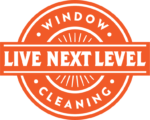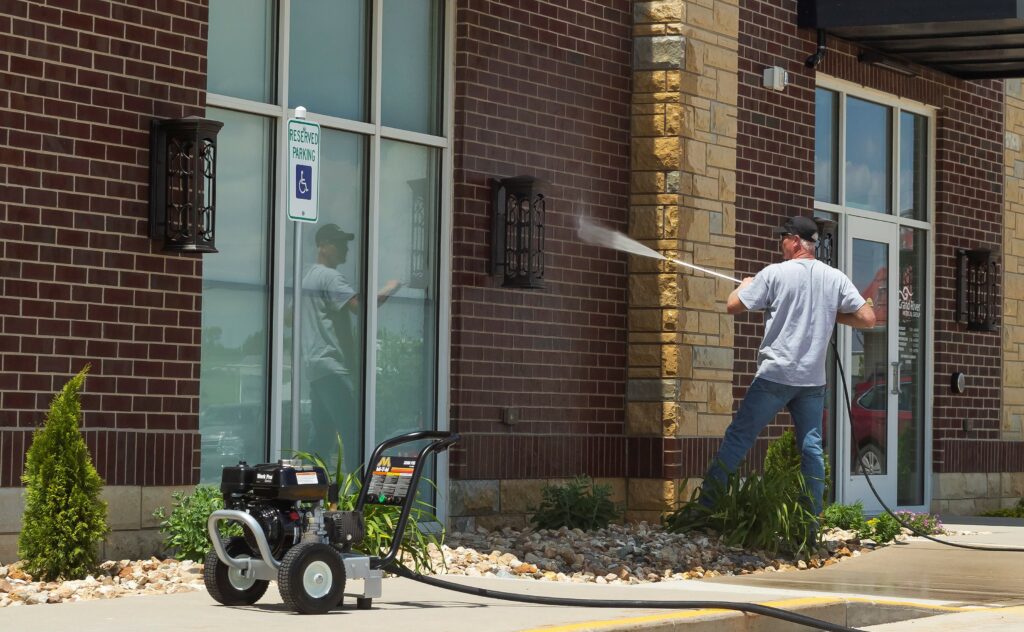Pressure washing is a powerful cleaning method that is used to remove dirt, grime, and other debris from exterior surfaces.
Advantages of pressure washing include its ability to quickly and effectively clean large areas with minimal effort.
However, without the proper safety precautions and knowledge of the different types of pressure washers available on the market, it can be dangerous to operate one.
This article provides an essential guide on how to safely and effectively use a pressure washer, as well as tips and techniques for getting the most out of your pressure washing experience.
Overview of Pressure Washing
Pressure washing is a method of cleaning that involves the use of pressurized water to remove dirt, debris, and other unwanted substances from hard surfaces. It is an effective and efficient way to clean a variety of materials, including concrete, wood, metal, and stone. Pressure washing can be used for both residential and commercial applications. When done correctly, it can leave surfaces looking like new with minimal effort.
The amount of water usage during pressure washing depends on the surface material being cleaned as well as the amount of dirt or debris present. Generally speaking, more water will be needed for tougher materials such as concrete or stone while less is needed for lighter materials such as wood or vinyl siding. The pressure level should also be adjusted accordingly based on the surface material in order to achieve optimal results.
In addition to its effectiveness at cleaning hard surfaces, pressure washing can also help remove stubborn stains and mold growths that are difficult to remove by hand scrubbing. This makes it an ideal choice for areas where these types of problems are prevalent due to dampness or moisture buildup over time. Proper safety precautions must always be taken when performing a pressure wash job since there is potential damage if used incorrectly on certain surfaces.
Types of Pressure Washers
Different types of pressure washers exist, each offering its own set of advantages and disadvantages to consider when choosing the right one for a particular job.
The most common type is an electric pressure washer, which can be used for both residential and commercial purposes. It is lightweight and easy to maneuver, however it has limited power compared to other models.
Gas-powered pressure washers are more powerful, but they are heavier and louder than their electric counterparts. Additionally, they require regular maintenance and have higher emissions levels.
Another option is a hot water pressure washer; these units often use diesel or kerosene as fuel sources and can reach temperatures up to 200 degrees Fahrenheit. While this allows for efficient cleaning of surfaces like concrete or plastic, it requires extra safety precautions due to the high heat output.
Finally, there are also specialized pressure washers that use detergents or chemicals in addition to water for enhanced cleaning capabilities on tough surfaces like grease or oil stains. These machines need specific setup procedures before usage and should only be operated by trained professionals due to their complex nature.
All types of pressure washers must be carefully selected based on the job requirements in order to get optimal performance while minimizing safety risks and environmental impact.
Choosing the Right Pressure Washer
Choosing the right pressure washer for a particular job can be a complex decision, as there are many factors to consider. To ensure the optimum result, it is important to select the most suitable machine for the task at hand.
Below are three key points that should be considered when making a decision:
- **Optimum Pressure** – The amount of pressure required will vary depending on the job and type of surface being cleaned. For general cleaning purposes, a pressure range between 1,000 and 3,000 PSI (pounds per square inch) is usually sufficient. However, if stubborn dirt or stains need to be removed then higher pressures may be necessary.
- **Flow Rate** – This refers to how much water flows through the power washer in gallons per minute (GPM). If you require more cleaning power then you may need a higher flow rate; however this also increases fuel consumption which can add costs to the job over time.
- **Surface Preparation** – Before starting any work with a power washer it is important to make sure that all surfaces are adequately prepared for cleaning by removing any loose debris such as leaves or stones from around the area being cleaned. Once this has been done then it is possible to begin working with your chosen machine without fear of damaging any surfaces due to foreign objects being blasted at them during cleaning operations.
When selecting a pressure washer it is important to consider these three points carefully in order to ensure that you have chosen an appropriate machine for your needs and budget, while also ensuring that no damage will occur due to incorrect selection of pressure or flow rate options before beginning work on any project.
How to Use a Pressure Washer Safely and Effectively
Proper use of a pressure washer requires an understanding of the safety precautions and techniques necessary to complete a job effectively.
For example, when using a pressure washer to clean a deck, one must take into account the type of surface and ensure that appropriate protective gear is worn in order to avoid injury from debris being blasted at high speed.
Damage prevention should also be considered when using a pressure washer. It is important to select the right amount of water pressure for the task, as too much water pressure can cause damage to surfaces or objects that may not be intended for cleaning. Likewise, it is important to ensure that any attachments used are designed specifically for use with a pressure washer in order to prevent further damage.
Using a detergent or cleaning solution can help improve the efficacy of the cleaning process when using a pressure washer; however, it is essential that these chemicals are used correctly and safely. Certain chemicals may require special protective gear such as gloves or face masks in order to protect oneself from contact with potentially hazardous materials. Additionally, some materials may not hold up well under extreme water pressures which can lead to costly repairs or replacements if not handled properly.
In order for users of pressure washers to achieve maximum results while avoiding injuries and preventing further damage, they should familiarize themselves with their specific equipment and read all user manuals prior to operation. This will ensure that they understand how best to operate their machine safely and effectively while also aiming for optimal results from their cleaning projects.
Pressure Washing Tips and Tricks
By utilizing a few basic techniques, users of pressure washers can maximize their results and achieve a better clean.
Pressure washing is an effective way to remove dirt, mildew, and grime from surfaces quickly, but it is important to prepare the surface before cleaning. Preparation includes clearing away any debris that might block the flow of water or interfere with the spray and repairing any cracks or holes in the surface.
After preparing the surface, it is important to choose an appropriate cleaning solution for the job at hand; this will depend on what type of material is being cleaned and how much dirt needs to be removed.
When using a pressure washer, it is essential to adjust the nozzle so that it sprays at an angle between 0-15 degrees relative to the surface. This will help avoid damage while still providing enough power to get rid of stubborn dirt. Additionally, users should ensure that they are standing far enough away from the surface during use; too close may cause excessive wear on surfaces over time.
When moving around walls or other objects with sharp edges, it is best practice to move slower than normal in order to avoid bounce-back from hard surfaces which could cause injury. Finally, when finished using a pressure washer always rinse off any detergent residue as part of maintenance and store equipment safely according to manufacturer’s instructions for future use.
It is also important for users of pressure washers take into account environmental concerns when cleaning exterior surfaces. Pressure washing can release chemicals such as fertilizers or pesticides if used improperly on contaminated areas like driveways or sidewalks; these chemicals can then contaminate nearby soil or groundwater if not disposed properly afterwards.
To prevent this from happening users should consider using biodegradable eco-friendly cleaners instead of harsh chemical solutions whenever possible. In addition it’s helpful for users monitor water runoff during cleaning projects; if large amounts of dirty water seem to be running off into storm drains then extra precautions should be taken in order minimize potential pollution impacts on local watersheds and aquatic ecosystems.
Conclusion
Pressure washing is an effective and efficient way to clean a variety of surfaces. With the right equipment, technique, and safety precautions in place, pressure washing can be a manageable task for all levels of experience.
To achieve the best results it is important to choose the correct pressure washer for the job and understand how to safely use it. Alluding to its importance, it has been said that “pressure washing is an art form”.
Understanding this art requires knowledge of the different types of pressure washers available, as well as learning tips and tricks to maximize efficiency. By mastering these basics, anyone can create beautiful outdoor spaces with ease.
- Meet The Founder – Brandon Gawdun - April 12, 2024
- Elevate Your Home: The Next Level Approach to Spring Cleaning - April 12, 2024
- Spring Events – Okanagan - April 12, 2024




